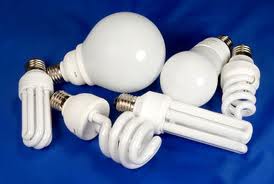“68 out of the 72 workers at the Nanhai Feiyang lighting factory in Foshan city where were so badly poisoned that they required hospitalization. At another CFL factory in Jinzhou, 121 out of 123 employees were found to have excessive mercury levels with one employee's mercury level 150 times the accepted standard. See wikipedia http://en.wikipedia.org/wiki/Compact_fluorescent_lamp”
“Dozens of workers who were interviewed on condition of anonymity, described living with the fear of mercury poisoning. They gave detailed accounts of medical tests that found numerous workers had dangerous levels of the toxin in their urine.”
“CFLs, like all fluorescent lamps, contain small amounts of mercury as vapor inside the glass

In the European Union, CFLs are one of many products subject to the WEEE recycling scheme.”
For some bizarre reason, special handling instructions for breakage are currently not printed on the packaging of household CFL bulbs in many countries. Even though the Maine Government
study showed that the amount of mercury released by one bulb can greatly exceed U.S. federal guidelines for chronic exposure. See http://maine.gov/dep/rwm/homeowner/cflreport.htm.
Chronic however, implies that the exposure continues constantly over a long period of time and the Maine DEP study noted that it remains unclear what the health risks are from short-term exposure to low levels of elemental mercury.
"The Maine DEP study also confirmed that, despite following EPA best-practice cleanup guidelines on broken CFLs, researchers were unable to remove mercury from carpet, and agitation of the carpet—such as by young children playing—created spikes as high as 25,000 ng/m3 in air close to the carpet, even weeks after the initial breakage"
"The U.S. Environmental Protection Agency (EPA) recommends that, in the absence of local guidelines, fluorescent bulbs be double-bagged in plastic before disposal.The Maine DEP study of 2008 compared clean-up methods, and warned that the EPA recommendation of plastic bags was the worst choice, as vapours well above safe levels continued to leach from the bags. The Maine DEP now recommends a sealed glass jar as the best repository for a broken bulb."
Because fluorescent light bulbs contain mercury which is poisonous to humans and animals, sealed within the glass tubing. EPA recommends the following clean-up and disposal steps, if a bulb is accidentally broken in the home, factory or supermarket: See http://www.epa.gov/cfl/cflcleanup.htm
Before Cleanup
Air Out the Room Have people and pets leave the room, and don't let anyone walk through the breakage area on their way out. Open a window and leave the room for 15 minutes or more. Shut off the central forced-air heating/air conditioning system, if you have one.Cleanup Steps for Hard Surfaces
Carefully scoop up glass pieces and powder using stiff paper or cardboard and place them in a glass jar with metal lid (such as a canning jar) or in a sealed plastic bag.
Use sticky tape, such as duct tape, to pick up any remaining small glass fragments and powder.
Wipe the area clean with damp paper towels or disposable wet wipes. Place towels in the glass jar or plastic bag.
Do not use a vacuum or broom to clean up the broken bulb on hard surfaces.
The next several times you vacuum, shut off the central forced-air heating/air conditioning system and open a window before vacuuming.Keep the central heating/air conditioning system shut off and the window open for at least 15 minutes after vacuuming is completed.
Cleanup Steps for Carpeting or Rug
Carefully pick up glass fragments and place them in a glass jar with metal lid (such as a canning jar) or in a sealed plastic bag.
Use sticky tape, such as duct tape, to pick up any remaining small glass fragments and powder.
If vacuuming is needed after all visible materials are removed, vacuum the area where the bulb was broken.
Remove the vacuum bag (or empty and wipe the canister), and put the bag or vacuum debris in a sealed plastic bag.
Cleanup Steps for Clothing, Bedding and Other Soft Materials
If clothing or bedding materials come in direct contact with broken glass or mercury-containing powder from inside the bulb that may stick to the fabric, the clothing or bedding should be thrown away.
Do not wash such clothing or bedding because mercury fragments in the clothing may contaminate the machine and/or pollute sewage.
You can, however, wash clothing or other materials that have been exposed to the mercury vapor from a broken CFL, such as the clothing you are wearing when you cleaned up the broken
CFL, as long as that clothing has not come into direct con tact with the materials from the broken bulb.
If shoes come into direct contact with broken glass or mercury-containing powder from the bulb, wipe them off with damp paper towels or disposable wet wipes. Place the towels or wipes
in a glass jar or plastic bag for disposal.
Disposal of Cleanup Materials
Immediately place all clean-up materials outdoors in a trash container or protected area for the next normal trash pickup.
Wash your hands after disposing of the jars or plastic bags containing clean-up materials.
Check with your local or state government about disposal requirements in your specific area. Some states do not allow such trash disposal. Instead, they require that broken and unbroken mercury containing bulbs be taken to a local recycling center.



Comments